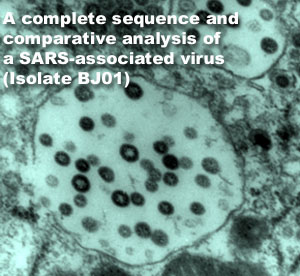
Chinese scientists announced on May 3 that they have finished complete genomic sequencing of another isolate of virus, which is associated with the Severe Acute Respiratory Syndrome (SARS).
A collaborative effort by scientists working with the Institute of Microbiology and Epidemiology, Chinese Academy of Military Medical Sciences and the Beijing Genomics Institute (BGI), Chinese Academy of Sciences has resulted in a comprehensive paper published on May 3 on the Internet edition of Chinese Science Bulletin.
By comparing the complete sequence of the Isolate BJ01 they produced and those of four other isolates identified in the United States, Canada and Hong Kong, scientists are able to get closer to the real killers in the SARS-associated virus, said Yang Huanming, director of the BGI and one of the co-authors.
The research done so far shows that the SARS-associated virus is very new, unlike all the other known viruses, he says.
"The genome sequence of the SARS-associated virus provides essential information for scientists to identify pathogen(s) and interprete transmission and pathogenesis,"Yang said.
The work will also pave a way for scientists to develop diagnostic tools and drugs for SARS and work out preventive measures such as by future vaccines, Yang said.
He said he and his colleagues found that the whole genome of SARS virus is composed of a stable protein, RNA-dependent polymerase, which accounts for two-thirds of the genome sequence and some variable proteins. Results of sequencing shows that two of the variable proteins, spike protein (S protein) and membrane protein (M protein) have a high mutation rate.
"It is these two kinds of proteins that help SARS virus to enter the human cells, and then cause the trouble," said Yang.
The comparative analysis indicates there are 31 substitutions among the variable proteins of the five complete genomes. Of the 31, nine can be found in two or three independent isolates of SARS virus.
"This shows that the SARS virus has strong variability," said Yang, "This will make it very difficult to produce SARS vaccines."
Phylogenetic studies show that the genome of Isolate BJ01 is similar to one of the isolates identified in Hong Kong. However, another isolate identified in Hong Kong might be closer to that from Toronto. The Toronto patient, from whom the isolate was obtained, travelled from Hong Kong, Yang said. The isolate from the United States appears to be the farthest from all others.
Yang and his colleagues have also compared SARS virus with 17 kinds of coronaviruses from both human beings and animals. These include four isolates from human beings, four from birds, two from rodents, seven from house animals or pets.
"But there is yet no evidence that SARS virus is linked with any of these viruses," he said.
BGI is currently trying to produce complete sequences of 10 isolates of SARS virus. The already completed genome sequence of Isolate BJ01 was obtained from the lung of a dead SARS patient in Beijing. Theses isolates of SARS virus were all provided by the Academy of Military Medical Sciences.
Yang said BGI has also completed the draft sequences of another three isolates of SARS virus from Beijing and an isolate of SARS virus from Guangzhou. (China Daily)





